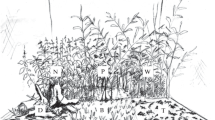Abstract—The foraging behavior of the blackbird and fieldfare in the city of Kaliningrad was studied. The similarity of the feeding habitats used by the thrushes is noted. The main type of fodder habitats during the reproductive period are lawns with low vegetation cover, rarefied as a result of human influence, while they are squares and gardens with fruit bushes and trees during the autumn and winter period. The use of fodder habitats and fodder objects of anthropogenic origin is noted for the blackbird out of its period of reproduction. The differences in nutrition behavior consist in the frequency and sequence of the use of foraging acts and are associated with the thrushes’ use of various quantities of objects from the soil and from its surface. During the breeding season, sweeping motions of the beak are the most characteristic for the blackbird, and digging up objects from the soil is typical for the fieldfare. The differences in the foraging behavior of the thrushes in Kaliningrad (in contrast to natural habitats) are expressed as an increased variety of the foraging methods used and a significantly prolonged duration of examination for the blackbird and fieldfare, respectively. These differences are due to the manifestation of specific features in specific places of feeding.
Similar content being viewed by others
REFERENCES
Akimova, T.A. and Haskin, V.V., Ekologiya (Ecology), Moscow: UNITI, 1998.
Baranovsky, A.V., Khlebosolov, E.I., Marochkina, E.A., Cheltsov, N.V., Lobov, I.V., Babushkin, G.M., and Ananeva, S.I.,The mechanisms of ecological segregation of four sympatric thrush species: Turdus pilaris, T. iliacus, T. philomelos, and T. merula, Russ. Ornitol Zh., 2007, express issue 16 (377), pp. 1219–1230.
Baranovsky, A.V., The mechanisms of ecological segregation of house and tree sparrows, Cand. Sci. (Biol.). Dissertation, Ryazan, 2004.
Fridman, V.S., Preadaptation of birds to settling the urban environment: Ethological aspects, in Ekopolis 2000: ekologiya i ustoichivoe razvitie goroda (Ecopolis 2000: Ecology and Sustainable Development of the City, Proc. 3rd Int. Conf.), Moscow: RAMN, 2000, pp. 176–178.
Ganya, I.M. and Zubkov, N.I., Adaptation of birds to anthropogenic environmental conditions, in Adaptatsiya ptits i mlekopitayushikh k antropogennomu landshaftu (Adaptation of Birds and Mammals to an Anthropogenic Landscape), Kishinev: Shtiintsa, 1988, pp. 34–55.
Gorelov, A.A., Ekologiya. Konspekt lektsii (Ecology: Compendium of Lectures), Moscow: Vysshee Obrazovanie, 2008.
Khlebosolov, E.I., Ekologicheskie faktory vidoobrazovaniya u ptits (Ecological Factors of Speciation in Birds), Moscow: Horizon, 1999.
Khlebosolov, E.I., The theory of niche in ecology: history and current status, Russ. Ornitol. Zh., 2002, express issue 203, pp. 1019–1037.
Kuranov, B.D., Peculiarities of bird urbanization, Contemp. Probl. Ecol., 2008, no. 1, pp. 123–132.
Lakin, G.F., Biometriya: uchebnoe posobie dlya biol. spets. vuzov (Biometrics: A Textbook for Biological Specialties of Higher Education Institutions), 4th ed., Moscow: Vysshaya Shkola, 1990.
Leonova, T.Sh., The pattern of biotopic distribution of house sparrow and tree sparrow in Kazan, Vestn. Udmurt. Gos. Univ., 2014, no. 4, pp. 62–66.
Lübcke, W. and Furrer, R.K., Die Wacholderdrossel: Turdus pilaris, Die Neue Brehm Bücherei, 1985, no. 569, pp. 1–198.
Luniak, M., Synurbanization: adaptation of animal wildlife to urban development, in Proc. 4th Int. Symp. on Urban Wildlife Conservation, W.W. Shaw, W.W., Harris, L.K., and Vandruff, L., Eds., Tucson: Univ. of Arizona Press, 2004, pp. 50–55.
Lykov, E.L., Avilova, K.V., and Boehme, I.R., Some aspects of the synanthropization of nine species from the Turdidae family in Kaliningrad, Vestn. Mosk. Gos. Univ., Ser. 16: Biol., 2009, no. 2, pp. 33–40.
Malchevsky, A.S. and Pukinsky, Yu.B., Ptitsy Leningradskoj oblasti i sopredelnykh territorik: Istoriya, biologiya, okhrana (Birds of Leningrad Oblast and Adjacent Territories: History, Biology, Protection), Leningrad: Leningr. Gos. Univ., 1983, vol. 2.
Reise, H. Untersuchungen zur Ökologie und Biologie der Amsel (Turdus merula) im Stadzentrum von Leipzig, Zool. Abhandlungen, 1990, vol. 45, pp. 155–178.
Shukshina, M.S., Features of foraging behavior of the Blackbird Turdus merula L. in Kaliningrad, Vestn. Mosk. Gos. Obl. Univ., Ser. Estestv. Nauki, 2015, no. 5, pp. 41–48.
Shukshina, M.S., Pattern of feeding behaviour of the Fieldfare Turdus pilaris L. in Kaliningrad, Printsipy Ekologii, 2016, vol. 5, no. 3, p. 160.
Sidenko, M.V., Ornithoifauna of the city of Rostov-on- Don: structure, dynamics, distribution, abundance, and ways of formation, Doctoral (Biol.) Dissertation, Stavropol, 2004.
Skilsky, I.V., On the degree of ornithofauna synanthropization: Approaches, methods, results (the example of the city of Chernovtsy), Berkut, 2001, vol. 10, no. 2, pp. 140–152.
Telpova, V.V., Comparative ecology of thrushes of the genus Turdus in the anthropogenic landscapes of Central Ciscaucasia, Cand. Sci. (Biol.) Dissertation, Moscow, 2006.
Tye, A., Ground-feeding methods and niche separation in thrushes, Wilson Bull., 1981, vol. 93, no. 1, pp. 112–114.
Author information
Authors and Affiliations
Corresponding author
Ethics declarations
The author declares that she had no conflict of interest. This article does not contain any studies involving animals or human participants performed by the author.
Additional information
Translated by L. Solovyova
Rights and permissions
About this article
Cite this article
Shukshina, M.S. Foraging Behavior Features of the Blackbird Turdus merula L. and Fieldfare Turdus pilaris L. (Turdidae, Passeriformes) in Kaliningrad. Biol Bull Russ Acad Sci 46, 1308–1312 (2019). https://doi.org/10.1134/S1062359019100303
Received:
Accepted:
Published:
Issue Date:
DOI: https://doi.org/10.1134/S1062359019100303




